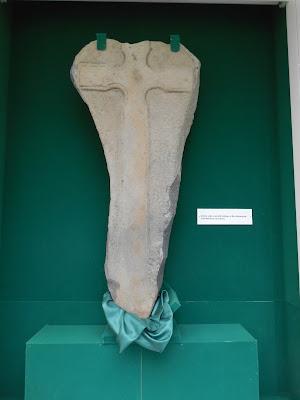Mahee Island can be accessed by car via the neighbouring Island Reagh. However you can only access the western end of the island as far as the site of the Nendrum Monastic Site. The rest of the island is private. Northern Ireland appears to have very few public footpaths and lots and lots of private, keep out notices. There is a 9 hole golf course on the island, which was founded in 1930.
The island takes its name from St Machaoi who set up a monastery on the island in the 5th century. The monastery consists of 3 concentric round dry stone walled enclosures. The central enclosure contains a ruined church and a sundial, the
remains of a round tower and a graveyard. The middle enclosure has the
remains of huts and workshops. It is the best example of a
pre-Norman monastic site in Northern Ireland. There
is a small car park and a visitor centre which has various displays,
models, artefacts, videos and most importantly a toilet. The site is not suitable for disabled
access, as it is up a steep slope. The views down Strangford Lough from the monastic site are stunning. When I visited in September 2015 there was no admission charge.

Round Tower
This was originally 27 metres tall and was probably built in the 10th century. Its main purpose was to call the monks to prayer at designated times of the day. Time was measured using a sundial, like the one shown below (I don't know how they measured it when the sun wasn't shining or during the hours of darkness). A monk would ring a hand bell from the top of the tower. The tower was also used as a treasury to store valuables and as place of refuge when the monastery was attacked. There were originally around 65 round towers on monastic sites in Ireland. They are known in Irish as cloigtheach, which means "bell house". This style of round tower is almost unique to Ireland. There are also 2 in Scotland (at Abernethy and Brechin) and one at Peel on the Isle of Man.

Reconstructed sundial
The nave of the chapel was built in the 10th century around the same time as the round tower but it probably replaced an earlier wooden church. In the 13th century long after the monastery had ceased to function it was converted into a parish church and a chancel was added. In the later Middle Ages the local congregation moved to the church on the mainland at Tullynakill and the church on Mahee Island became a ruin. The site was rediscovered in 1844 by William Reeves, who later became the Bishop of Down and Connor came in search of the sites mentioned in a papal taxation record of 1306. He realised he had found the site of Nendrum when he was shown the ruin of the round tower. However the site remained overgrown and neglected until it was excavated 1922-24 by the Belfast Natural History and Philosophical Society led by HC Lawlor. It has been care for by the Department of the Environment since 1973.

Chapel ruins and sundial
 Chapel and Round Tower
Chapel and Round Tower

An example of a Nendrum Cross in the Visitor Centre
This is a Latin Cross with hollows at the "armpits" where the arms meet the shaft. This design is characteristic of Nendrum and a few other nearby sites in County Down.
Nendrum Visitor Centre
Mahee Castle is located
at the western end of the island facing Reagh Island and adjacent to
the modern causeway. There is public access to the ground floor. There
is no car park but it is only about 300 metres from the car park at
Nendrum. I found lots of lovely blackberries to eat along the way. The
tower house is thought to have been built in 1570 by an English soldier
called Captain Browne. There was a secure boat bay on the ground
floor.
Mahee Castle
Mahee Castle from the Reagh Island Causeway
Memorial plaque commemorating the building of the walls at the sides of the causeway between Reagh and Mahee Island
The walls were built in memory of a local man called Robert Ardill, who died on 30th October 1921. According to the Comber Historical Society website he was a local man who either drowned or was killed by the shock of the cold water off Mahee Island when he fell in while transferring from one boat to another. There is another much larger conical stone memorial to him at the eastern end of the island. The only way to access this is by boat, as the land adjacent is private with no public access.
The remains of two very old tide mills can be seen from the monastic ruins. These were excavated 1999-2001. It had previously been thought that the remains were of fish traps. There wasn't any fresh water on the island to provide power for a conventional water mill, so the monks constructed the first tide mill across the small bay below the monastic site in 619 (I have no idea how it has been dated so precisely). This tide mill is currently the earliest
known example of a tide mill in the world. At high tide the water was
trapped behind a dam and then the water was released at low tide as a
high pressure stream of water, which powered a horizontal water mill. The second smaller tidal mill was constructed within the earlier on in 789. Both can clearly be seen at low tide - see photos below.
The oldest tide mill
The second tide mill